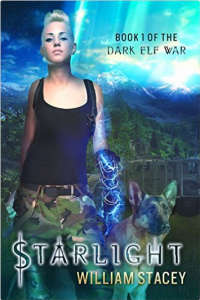I met William Stacey through an online writer’s group. His manuscript for Black Monastery impressed me so I reached out to him and became one of his beta readers. That novel did well, becoming a Breakthrough Novel Award Quarter-Finalist on Amazon in 2014.
He is a former army intelligence officer who served his country for more than thirty years with operational tours in Bosnia and Afghanistan; a husband, father, and avid reader with a love for the macabre; and last but not least a skilled and thoughtful writer. I knew he would write a great blog, and he did not disappoint!
Look for Part 2: The Female Knight in History coming later this month.

Twenty-year-old university dropout Cassie Rogan has returned to her small British Columbia home. Tortured by an accident that killed her parents, she drifts, failing life at every turn. When an uncanny lightning storm hits the forest, Cassie discovers that, after centuries of atrophy, the forces of magic are flowing back into our world, and Cassie can wield arcane powers. But everything comes with a price… Available on Amazon.
**Spoiler Alert!**
There’s a brutal swordfight in episode 10 of season 4 of Game of Thrones when Brienne of Tarth goes toe-to-toe with thuggish Sandor, “the Hound,” Clegane. To HBO’s credit, the fight is violent, exciting, bloody—and most importantly—completely believable. It was easily one of the best things I saw all last year on television. Gwendoline Cristie’s portrayal of tragically noble warrior Brienne is nothing short of amazing.
But…even in the make-believe world of Westeros, Brienne is an aberration.
She is consistently underappreciated and often the subject of scorn, ridiculed by both men and women (I’m looking at you, Cercei Lannister). George is an amazing writer, and his portrayal of a female warrior in a fantasy setting was, in my opinion, perfect—because—as unpopular as this may be with some—there has been only a very, very small percentage of female warriors throughout history. Right or wrong, warfare has pretty much always been a boy’s club.
Now, I get it. Westeros is a fantasy setting, not reality. However, I think Westeros is also pretty obviously modeled on medieval Europe. In fact, so is most fantasy fiction produced in the West. I’m not going to imply that this is somehow wrong; certainly I’ve used medieval Europe as a mirror for much of my own fiction. I think it’s normal to create worlds similar to what we’re already familiar with (although some would also call it boring… but hey, people also say that the zombie craze is over, yet we’re getting a new Walking Dead series spin-off). European history is immediately relatable to most readers. Call a character a knight and a picture pops into our heads—even if that picture is often biased by the movies. Writers can introduce a little bit of world building—put in a castle, a few knights, a dragon—and readers are good to go.
Fiction isn’t reality, I do get that, but grounding a story in history can often make it much more believable. If you need an example, read anything by Bernard Cornwell. He writes the best medieval combat out there because he researches everything. So, if fantasy is more realistic when it’s modeled on real history, what’s the state of women warriors in fiction today? Is Brienne of Tarth a believable character? What about Lagertha, the famous Viking shield maiden who fought beside Ragnar Lothbrok? How are we writers doing with our heroic female warriors? Well… not bad, actually.
Let’s start with Lagertha and female Vikings. Did shield maidens exist? Sadly, probably not—at least there’s no firm historical evidence that they did, and certainly not as a significant portion of any Viking military force. Did (at least some) Norse women fight in battles? Absolutely, just as there are anecdotal examples of women who fought as warriors in medieval Europe. Historically, though, these examples are so few and far between as to be statistically irrelevant. There is little-to-no proof that female warriors ever accompanied Viking armies in large numbers, and likely 99.9% of Viking warriors were male. It’s possible that the enduring legends of Viking shield maidens are confused with that of the Valkyries, Odin’s female (but not human) messengers who carried fallen warriors to Valhalla.
Admittedly, history isn’t always black and white, and not all historians agree on the existence of shield maidens with some insisting that they did exist. The twelfth century historian Saxo Grammaticus wrote of the heroic Lagertha (Lathergertha in his writings) as well as other shield maidens who fought with the Viking armies. The problem with Saxo, however, is that his histories are considered by some to be largely fictional, including details from myth and legend. As a credible source, Saxo isn’t.
Still some people remain convinced that there were, indeed, female Viking warriors. The History Channel’s outstanding Vikings series—with the incredibly cool Lagertha portrayed by Katheryn Winnick—may be reinforcing these beliefs. In 2014, an article (bearing a picture of Katheryn Winnick as Lagertha) was published on Tor.com with the headline, “Better Identification of Viking Corpses Reveals: Half of the Warriors Were Female.” The source for this new information was a paper published in 2011 in the journal Early Medieval Europe, written by Shane McLeod, where, following reexaminations of Viking burial sites in Britain, McLeod proposed that the ratio of female-to-male Viking settlers may have been much higher than was previously thought. Through osteological sexing (bone analysis) of fourteen burial sites in Britain, six were found to likely be female. McLeod concludes by suggesting that maybe a third to one half of Viking setters—not warriors, setters—may have been female. Fair enough. That’s an interesting finding and bears further investigation; after all, fourteen burial sites is hardly a significant sample. The problem, though, began when some took McLeod’s findings and twisted them to say something that he wasn’t at all saying—namely that half of all Viking warriors were female. They weren’t. And while some female Norse burial sites have been found to contain swords and other traditionally male-centric items, that’s hardly proof those women were warriors. It just means they were buried with weapons. Judith Jesch, the Professor of Viking Studies at the University of Nottingham, stated, “It is likely that there were occasions when women had to defend themselves and their families as best they could, with whatever weapons were to hand. But there is absolutely no hard evidence that women trained or served as regular warriors in the Viking Age….Women warriors must be classed as Viking legend.”
I’ll repeat what I wrote earlier: fiction isn’t reality, and certainly fantasy fiction is even further removed from reality. Historically, shield maidens may only be legend, but so were dragons—and those glorious, fire-breathing creatures aren’t going anywhere. Authors need to decide for themselves. In my latest fantasy novel, The Sword of Heaven: Book 1 of the Vampire Queen, I have Viking-like female warriors fighting side by side with their male counterparts, but I also have a European-styled medieval kingdom where gender expectations forbid women from bearing arms. I accept that shield maidens didn’t exist, but I’m putting them in the book anyhow. My story-world, I can do as I want. However, if I were to write another historical Viking story, such as I did with Black Monastery—rather than a Viking-like story—I probably wouldn’t include the historically inaccurate shield maidens.
So, sorry, Lagertha, while I don’t believe you ever existed, I still think you rock!



